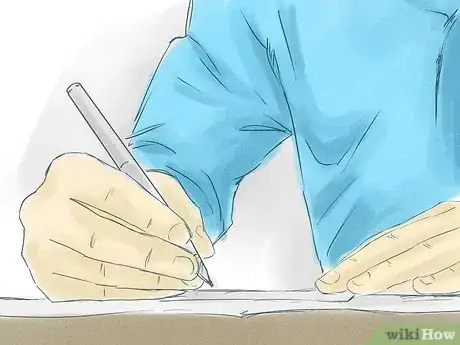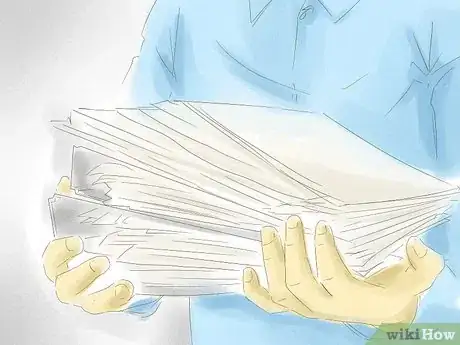This article was written by Jennifer Mueller, JD. Jennifer Mueller is an in-house legal expert at wikiHow. Jennifer reviews, fact-checks, and evaluates wikiHow's legal content to ensure thoroughness and accuracy. She received her JD from Indiana University Maurer School of Law in 2006.
There are 11 references cited in this article, which can be found at the bottom of the page.
This article has been viewed 84,071 times.
If you disagree with a decision the judge has made in your case, you have several options you can pursue to get the decision reviewed. A motion for reconsideration asks the judge (usually the same one) to reconsider his decision in light of other facts, circumstances, or law that wasn't brought up in the original hearing on the matter. Motions for reconsideration typically must be filed within ten days after the judge issues his order.[1]
Steps
Drafting Your Motions
-
1Determine if you need to file a motion for stay. If the original order requires something that will bring you harm, you may want to file a motion for stay so the order won't be enforced while your motion for reconsideration is pending.
- For example, if the original order grants ownership of your car to someone who intends to destroy it, you might file a motion for stay pending reconsideration to keep the other person from destroying your car.
- If something is going to happen in the next 7-10 days, you should file an emergency motion for stay. An emergency motion for stay typically is heard on the same day as you file it, or the day after. Otherwise you just need a motion for stay.[2]
-
2Look for forms. You may be able to find a form for your motion online or in the clerk's office; however, post-judgment motion forms are rare.Advertisement
-
3Format your motions. You must format your motions in the same way as other pleadings in your case. The caption, case name and number, and signature blocks all will be the same.
-
4Write your motion for stay. The motion for stay asks the judge to hold off on enforcing his order while your motion for reconsideration is pending.
- If you're styling your motion as an emergency motion for stay, you also must explain what the emergency is that requires the motion to be heard immediately.[5]
- Find the court's rule in your jurisdiction that allows you to file the motion, and reference it in the first paragraph of your motion. Generally, you must begin your motion by stating who you are, what you are asking of the judge, and which rule gives you permission to ask.
-
5Write your motion for reconsideration. The motion for reconsideration asks the judge to reconsider her earlier ruling in light of new facts that have come to light.
- Just as with your motion to stay, begin your motion for reconsideration by stating who you are, what you are asking of the judge, and which rule gives you permission to ask.
- From there on out, use the rule itself as a general outline for your motion.
- Judges typically don't schedule live hearings for motions for reconsideration. If you want to have a hearing, you can type "Oral Hearing Requested" at the top of your motion next to the caption. Keep in mind the judge doesn't have to grant your request.[6]
-
6Write your affidavit. In many jurisdictions you must write an affidavit to accompany your motion for reconsideration.
- In the affidavit you'll list specifically the new facts, circumstances, or law that forms the basis of the motion. Then you'll demonstrate how those facts, circumstances, or law affect the decision in the original order, and why the original order must be changed accordingly.[7]
- The specific facts required for a motion for reconsideration are very specific, so you should make sure you've read your court's rules about the motion very carefully before proceeding.
-
7
Filing Your Motions
-
1Gather your exhibits. Organize any supporting evidence or documents you need to attach to your motions.
- You also should attach a copy of the original order you're asking the judge to reconsider.
-
2Sign your motions and affidavit. Sign your documents in the presence of a notary public.
- If you don't know where to find a notary, call your bank and find out if they have one. Many banks provide notary service free to their customers. You also can find notaries in some private businesses such as check-cashing services, and at the courthouse, although you should expect to pay a small fee.[10]
-
3Make copies of all your paperwork. Once you've signed your motions, compile them together with all your exhibits and other papers and make enough copies for your own records and for all parties in the case.[11]
-
4File your motions. You must file your motions in the clerk's office of the same court where your original case was heard.
- The clerk stamps your originals and copies "filed" with the date, then keeps the originals for the court. One of the copies is yours; the rest are to send to other parties in your case.[12]
- You'll have to pay a filing fee to file your motions, although it may only be about $10. If you can't afford the fees, you can fill out an application at the clerk's office to have the fees waived.[13]
-
5Have your motions served on the other side. After you've filed your motions, send them to the other parties in the case so everyone has notice of them.
- Ask the court clerk if any particular service is required. Otherwise you may serve the documents by sending them using certified mail. If you're required to serve the documents in person, consider using the sheriff's office or a private process serving company.[14]
-
6Attend your hearing, if required. Not all jurisdictions require full hearings on notices to stay or for reconsideration, but some judges prefer them in certain cases.[15]
Examining Other Options
-
1Talk to an attorney. Because post-judgment law and procedure can be complicated, it can be a good idea to talk to an attorney at this point if you still aren't satisfied with the judge's ruling.
- If you cannot afford an attorney, contact your local bar association to learn about free or reduced-cost legal assistance available in your area. For example, the Colorado Bar Association provides free volunteer attorneys in a small number of civil appeals cases.[16]
-
2Consider filing an appeal. If you file an appeal, you are requesting that appellate court judges review the trial court judge's decision.
- Appeals courts don't conduct a new trial, they only review the court record from the original trial. They can't consider new evidence. For these reasons, if you disagree with the judge's decision because new facts or circumstances have come to light, filing an appeal may not work in your situation.
- However, if you believe the judge made a mistake considering the facts he had in front of him, an appeal might benefit you.[17]
- The deadline for filing an appeal typically doesn't start until after the judge has entered a ruling on your motion for reconsideration. However, you should check with your local rules to see how much time you have before you file an appeal.
-
3Consider filing a motion to vacate. A motion to vacate asks the court to withdraw the previous judgment because you didn't have a fair chance to present your case.
- Keep in mind that a motion to vacate is not the same as an appeal or a motion for reconsideration. A motion to vacate doesn't ask the judge to reconsider his opinion or to consider new evidence.
- If you've already filed a motion for reconsideration, a motion to vacate probably is not available to you, because you've had a chance to present your case. A motion to vacate might be granted if, for example, someone had sued you but never served you with papers, so you didn't know about the lawsuit and a default judgment was entered.
-
4Consider filing a motion for a new trial. New trial motions typically are based on some sort of error, misconduct, or abuse of discretion that substantially violated your rights.[18]
- Because the deadline for filing a motion for a new trial and the deadline for filing a motion for reconsideration typically are the same, if you've already filed a motion for reconsideration then your window of opportunity to file a motion for a new trial probably has closed.[19]
Warnings
- Make sure you meet the threshold requirements for filing a motion for reconsideration before you do so. These motions are burdensome and time-consuming for the courts, and should only be used when you have specific facts, circumstances, or law that was not shown at the original hearing. If you don't meet those requirements but file a motion anyway, you risk being held in contempt of court or subject to severe financial penalties.[20]⧼thumbs_response⧽
References
- ↑ http://www.courts.ca.gov/5804.htm
- ↑ http://www.lawhelp.org/dc/resource/appeals-and-motions-for-reconsideration-in-la#nineteen
- ↑ https://www.courts.state.co.us/Forms/renderForm1.cfm?Form=365
- ↑ http://www.superiorcourt.maricopa.gov/sscdocs/pdf/gn10fz.pdf
- ↑ http://www.lawhelp.org/dc/resource/appeals-and-motions-for-reconsideration-in-la#nineteen
- ↑ http://www.lawhelp.org/dc/resource/appeals-and-motions-for-reconsideration-in-la#two
- ↑ http://www.courts.ca.gov/5804.htm
- ↑ http://www.lawhelp.org/dc/resource/appeals-and-motions-for-reconsideration-in-la#one
- ↑ http://www.superiorcourt.maricopa.gov/sscdocs/pdf/gn10f.pdf
- ↑ https://www.asnnotary.org/?form=locator
- ↑ http://www.superiorcourt.maricopa.gov/sscdocs/pdf/gn10fz.pdf
- ↑ http://www.superiorcourt.maricopa.gov/sscdocs/pdf/gn10fz.pdf
- ↑ http://www.lawhelp.org/dc/resource/appeals-and-motions-for-reconsideration-in-la#two
- ↑ http://www.superiorcourt.maricopa.gov/sscdocs/pdf/gn10fz.pdf
- ↑ http://www.lawhelp.org/dc/resource/appeals-and-motions-for-reconsideration-in-la#one
- ↑ https://www.courts.state.co.us/Forms/SubCategory.cfm?Category=Appeals
- ↑ http://www.lawhelp.org/dc/resource/appeals-and-motions-for-reconsideration-in-la#one
- ↑ http://www.courts.wa.gov/court_rules/?fa=court_rules.display&group=sup&set=CR&ruleid=supcr59
- ↑ http://www.courts.wa.gov/court_rules/?fa=court_rules.display&group=sup&set=CR&ruleid=supcr59
- ↑ https://www.avvo.com/legal-guides/ugc/why-you-should-not-file-a--motion-for-reconsideration
About This Article
A motion of reconsideration is when you file a request for a judge to reconsider their decision in light of new information or evidence that wasn’t presented at trial. You may be able to get a template form from the clerk’s office to fill out your motion. Alternatively, consult with an attorney to file the form on your behalf. You may also need to file a motion to stay if the court decision will have an impact on you. A motion to stay will suspend the judge’s original ruling until the motion for reconsideration has been examined. Once you’ve filed the form, you’ll also need to send it to the other parties in the case so they have notice of it. For tips from our Legal co-author on how to decide whether to file a motion of reconsideration or request an appeal, keep reading!














































































